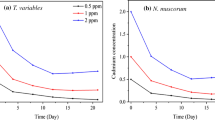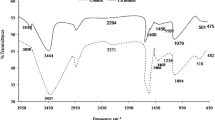Abstract
In this study, Nostoc muscorum, a native cyanobacterial species isolated from a coal mining site, was employed to remove Cu(II), Zn(II), Pb(II) and Cd(II) from aqueous solution containing these metals in the mixture. In this multicomponent study, carried out as per the statistically valid Plackett-Burman design of experiments, the results revealed a maximum removal of both Pb(II) (96.3 %) and Cu(II) (96.42 %) followed by Cd(II) (80.04 %) and Zn(II) (71.3 %) at the end of the 60-h culture period. Further, the removal of these metals was attributed to both passive biosorption and accumulation by the actively growing N. muscorum biomass. Besides, the specific removal rate of these metals by N. muscorum was negatively correlated to its specific growth rate. For a better understanding of the effect of these metals on each other’s removal by the cyanobacteria, the results were statistically analyzed in the form of analysis of variance (ANOVA) and Student’s t test. ANOVA of the metal bioremoval revealed that the main (individual) effect due to the metals was highly significant (P value <0.05) on each other’s removal. Student’s t test results revealed that both Zn(II) and Pb(II) strongly inhibited both Cu(II) removal (P value <0.01) and Cd(II) removal (P value <0.02). All these results not only demonstrated a very good potential of the cyanobacteria in the bioremoval of these metals but also the effect of individual metals on each other’s removal in the multicomponent system.



Similar content being viewed by others
References
Smejkalova, M., Mikanova, O., & Boruvka, L. (2003). Effects of heavy metal concentrations on biological activity of soil microorganisms. Plant, Soil and Environment, 49(7), 321–326.
Ahmet, S., & Mustafa, T. (2008). Biosorption of cadmium (II) from aqueous solution by red algae (Ceramium virgatum): equilibrium, kinetic and thermodynamic studies. Journal of Hazardous Materials, 157, 448–454.
Won, S. W., Kotte, P., Wei, W., Areum Lim, A., & Yun, Y. S. (2014). Biosorbents for recovery of precious metals. Bioresource Technology, 160, 203–212.
Babu, B. V., & Gupta, S. (2008). Adsorption of Cr (VI) using activated neem leaves as an adsorbent: kinetic studies. Adsorption, 14, 85–92.
Kotrba, P., Doleckova, L., Lorenzo, V., & Ruml, T. (1999). Enhanced bioaccumulation of heavy metal ions by bacterial cells due to surface display of short metal binding peptides. Applied and Environmental Microbiology, 65(3), 1092–1098.
Gikas, P. (2008). Single and combined effects of nickel (Ni (II)) and cobalt (Co (II) ions on activated sludge and on other aerobic microorganisms: a review. Journal of Hazardous Materials, 159, 187–203.
Acikel, U., & Alp, T. (2009). A study on the inhibition kinetics of bioaccumulation of Cu (II) and Ni (II) ions using Rhizopus delemar. Journal of Hazardous Materials, 168(2–3), 1449–1458.
Prasanna, R., Jaiswal, P., & Kaushik, B. D. (2008). Cyanobacteria as potential options for environmental sustainability—promises and challenges. Indian Journal of Microbiology, 48, 89–94.
Cain, A., Vannela, R., & Woo, L. K. (2008). Cyanobacteria as a biosorbent for mercuric ion. Bioresource Technology, 99, 6578–6586.
Bender, J., & Phillips, P. (2004). Microbial mats for multiple applications in aquaculture and bioremediation. Bioresource Technology, 94, 229–238.
Roeselers, G., Loosdrecht, M. C. M., & Muyzer, G. (2008). Phototrophic biofilms and their potential applications. Journal of Applied Phycology, 20, 227–235.
Roy, D., Greenlaw, P. N., & Shane, B. S. (1993). Adsorption of heavy metals by green algae and ground rice hulls. Journal of Environmental Science and Health, Part A: Environmental Science and Engineering & Toxic and Hazardous Substance Control, 28, 37–50.
Saeed, A., Iqbal, M., & Waheed, A. (2005). Removal and recovery of lead (II) from single and multimetal (Cd, Cu, Ni, Zn) solutions by crop milling waste (black gram husk). Journal of Hazardous Materials, 117(B), 65–73.
Sulaymon, A.H., Ebrahim, S.H., and M-Ridha, M.J. (2003) Competitive biosorption of Pb (II), Cr (III), and Cd (II) from synthetic wastewater onto heterogeneous anaerobic biomass in single, binary and ternary batch systems. Desalin. Water. Treat. 1–10 doi: 10.1080/19443994.2013.813008.
Hazarika, J., Pakshirajan, K., Sinharoy, A., and Syiem, M.B. Bioremoval of Cu (II), Zn (II), Pb (II) and Cd (II) by Nostoc muscorum isolated from a coal mining site. J. Appl. Phycol. DOI: 10.1007/s10811-014-0475-3.
Flouty, R., & Estephane, G. (2012). Bioaccumulation and biosorption of copper and lead by a unicellular algae Chlamydomonas reinhardtii in single and binary metal systems: a comparative study. Journal of Environmental Management, 111, 106–114.
Haider, A. M., & Pakshirajan, K. (2007). Screening and optimization of media constituents for enhancing lipolytic activity by a soil microorganism using statistically designed experiments. Applied Biochemistry and Biotechnology, 141, 377–390.
Ho, Y. S., & McKay, G. (1998). Sorption of dye from aqueous solution by peat. Chemical Engineering Journal, 70(2), 115–124.
Mehta, S. K., & Gaur, J. P. (2005). Use of algae for removing heavy metal ions from wastewater: progress and prospects. Critical Reviews in Biotechnology, 25, 113–152.
Puranik, P. R., & Paknikar, K. M. (1999). Influence of co-cations on biosorption of lead and zinc—a comparative evaluation in binary and multimetal systems. Bioresource Technology, 70, 269–276.
Fraile, A., Penche, S., Gonza’lez, F., Bla’zquez, M. L., Mun˜oz, J. A., & Ballester, A. (2005). Biosorption of copper, zinc, cadmium and nickel by Chlorella vulgaris. Chemistry and Ecology, 21, 61–75.
Sheng, P. X., Ting, Y. P., & Chen, J. P. (2007). Biosorption of heavy metal ions (Pb, Cu, and Cd) from aqueous solutions by the marine alga Sargassum sp. in single- and multiple-metal systems. Industrial and Engineering Chemistry Research, 46, 2438–2444.
Gupta, V. K., & Rastogi, A. (2008). Biosorption of lead (II) from aqueous solutions by non-living algal biomass Oedogonium sp. and Nostoc sp.—a comparative study. Colloids and Surfaces B Biointerfaces, 64, 170–178.
Chen, S. B., Ma, Y. B., Chen, L., & Xian, K. (2010). Adsorption of aqueous Cd2+, Pb2+, Cu2+ ions by nano-hydroxyapatite: single- and multi-metal competitive adsorption study. Geochemical Journal, 44, 233–239.
Tsezos, M., & Remoundaki, E. (1997). Recent advances in the mechanistic understanding of metals mobility and interaction with microbial biomass. Research in Microbiology, 148, 515–517.
Plazinski, W., Rudzinski, W., & Plazinska, A. (2009). Theoretical models of sorption kinetics including a surface reaction mechanism: a review. Advances in Colloid and Interface Science, 152, 2–13.
Acknowledgments
The authors thank the Department of Biotechnology, Government of India (BT/216/NE/TBP/2011) for providing the necessary financial support for this research work. They also thank Mr. M. Gopi Kiran, Centre for the Environment, IIT Guwahati, India, for his help in heavy metal analyses of the samples.
Conflict of Interest
The authors declare that they have no conflict of interest.
Author information
Authors and Affiliations
Corresponding author
Rights and permissions
About this article
Cite this article
Roy, A.S., Hazarika, J., Manikandan, N.A. et al. Heavy Metal Removal from Multicomponent System by the Cyanobacterium Nostoc muscorum: Kinetics and Interaction Study. Appl Biochem Biotechnol 175, 3863–3874 (2015). https://doi.org/10.1007/s12010-015-1553-y
Received:
Accepted:
Published:
Issue Date:
DOI: https://doi.org/10.1007/s12010-015-1553-y




